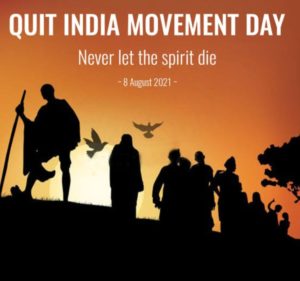The “Quit India Movement” was a significant civil disobedience movement launched by Mahatma Gandhi on August 8, 1942, during India’s struggle for independence from British rule. The movement aimed to demand an immediate end to British colonial rule in India and gain full independence. It encouraged non-violent protests, strikes, and mass civil disobedience across the country. The Quit India Movement played a pivotal role in India’s journey towards independence and remains an essential chapter in the nation’s history.
Table of Contents

History of “Quit India Movement Day”
The Quite India Movement also known as the August Movement or Bharat Chhodo Andolan, was a significant chapter in India’s struggle for independence against British colonial rule. It was launched on August 8, 1942, during World War II, by Mahatma Gandhi, the prominent leader of the Indian independence movement.
Gandhi called for non-violent civil disobedience to demand an immediate end to British rule in India. The movement aimed to create mass protests and mobilize the Indian population for a final push towards independence. Gandhi’s famous slogan “Do or Die” became the rallying cry for millions of Indians seeking freedom.
The British responded with harsh repression, arresting thousands of Indian leaders, including Gandhi himself. Despite the arrests, the movement continued to gain momentum, with strikes, demonstrations, and acts of non-cooperation spreading across the country.
The Quit India Movement played a crucial role in pressurizing the British government to consider India’s independence seriously. It also marked a turning point in India’s history, as it showcased the unwavering determination and unity of the Indian people in their pursuit of freedom.
Finally, after years of struggle, India gained independence on August 15, 1947, marking the end of nearly 200 years of British colonial rule and the beginning of a new era for the nation. The Quit India Movement remains a symbol of the indomitable spirit and sacrifice of the Indian people in their fight for self-determination.
Celebration of Quit India Movement Day
significant milestone in India’s struggle for independence from British colonial rule. On August 8, 1942, Mahatma Gandhi launched the Quit India Movement, also known as the August Kranti, urging the people of India to demand an end to British rule. It was a call for non-violent civil disobedience and mass protests across the country. By celebrating this day, we remember the sacrifices made by freedom fighters and the collective spirit of Indians in their fight for independence. It serves as a reminder of the importance of unity and determination in achieving national freedom and sovereignty.
Significance
Leaders who later became well-known leaders, including Ram Manohar Lohia, J.P. Narayan, Aruna Asaf Ali, Biju Patnaik, and Sucheta Kripalani, were involved in underground activities.
Women participated actively in the movement. Usha Mehta, among other female activists, contributed to the establishment of an underground radio station that sparked awareness of the movement.
As a result of the Quit India Movement, there is a stronger sense of brotherhood and unity. Many college and high school students dropped out, and many adults quit their jobs and withdrew money from the banks.
The British came to the crucial conclusion that India was ungovernable in the long run as a result of the costs of World War II, even though the Quit India campaign was crushed in 1944 as a result of their refusal to grant immediate independence and instead insisting that it could only happen after the war had ended. In the end, it helped pave the road for India’s independence by altering the nature of political negotiations with the British.
Why To Celebrate
The Quit India Movement, also known as the Bharat Chhodo Andolan, was a pivotal event in India’s struggle for independence from British colonial rule. Celebrating the Quit India Movement holds immense significance for several reasons.
Firstly, the movement, launched on August 9, 1942, marked a turning point in India’s fight for freedom. It showcased the unity and determination of the Indian people, transcending regional, religious, and social divides, as they came together under the leadership of Mahatma Gandhi. This collective effort demonstrated the power of nonviolent resistance as a formidable tool to challenge colonial authority.
Secondly, celebrating the Quit India Movement reminds us of the sacrifices made by countless freedom fighters who faced imprisonment, brutality, and even death in their unwavering pursuit of independence. Their courage and resilience continue to inspire generations, serving as a reminder of the price paid for freedom.
Thirdly, the Quit India Movement ultimately led to the weakening of the British Empire’s hold on India, hastening the process of decolonization. The movement’s impact resonates globally, as it highlighted the power of peaceful resistance and sparked similar struggles for independence in other colonies.
Lastly, commemorating the Quit India Movement encourages us to cherish and safeguard the hard-fought freedom and democracy we now enjoy. It serves as a reminder of the importance of maintaining the principles of justice, equality, and inclusivity that formed the core of India’s struggle for independence.
Conclusion
In conclusion, celebrating the Quit India Movement is essential to honor the legacy of those who fought for India’s freedom, learn from their example, and preserve the values that form the foundation of our nation. It reminds us of the enduring power of unity, nonviolent resistance, and the quest for justice and self-determination.
As we observe the Quit India Movement Day, we must cherish the principles of justice, equality, and inclusivity that guided the struggle for freedom. It encourages us to safeguard the democratic values that form the bedrock of our nation and to remain vigilant in upholding them.
In conclusion, the Quit India Movement Day holds profound significance as a day of remembrance, appreciation, and reflection. It symbolize the indomitable spirit of a nation fighting for its freedom and stands as a testament to the power of unity, nonviolent resistance, and the relentless pursuit of justice and self-determination.
Click on the following link
